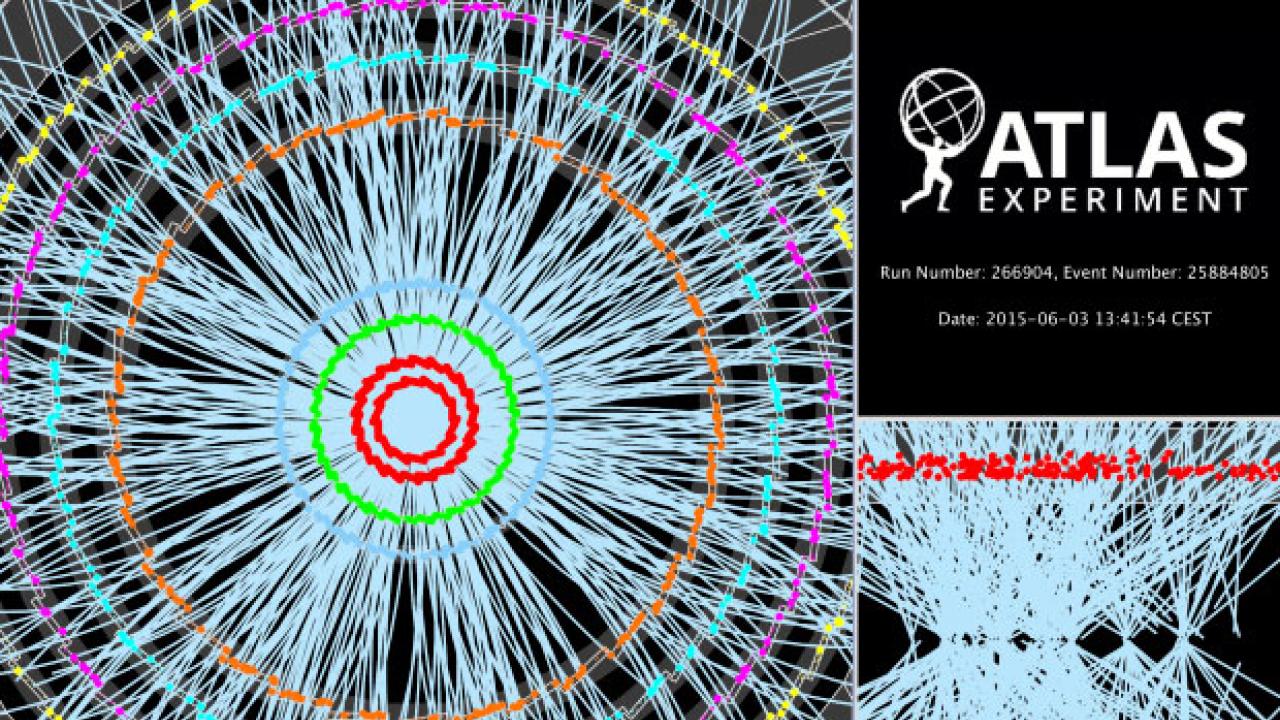
At the end of 2015, many physicists tuned in to a CERN webcast to hear the latest results of the particle-smashing ATLAS and CMS experiments performed at CERN’s Large Hadron Collider (LHC) beneath the French-Swiss border. Rumours about evidence of a new type of particle had been flying for days before the experiments presented their data collected during 2015. Immediately afterwards, theorists published a flood of papers, all excited about what those presentations hinted at: a possible signal of a new particle.
While that potential discovery received wide attention in the media, a lot of other types of data are still being analysed and will fuel publications for months to come. ICTP physicist and LHC ATLAS experiment collaborator Bobby Acharya explained the possible new particle hype and shared some of his own research group's hopes for the 2015 LHC data. ICTP and the University of Udine, working under the umbrella of the Italian National Institute of Nuclear Physics (INFN), have played an important role in ATLAS.
ATLAS is one of seven detection experiments set up within the LHC complex, all buried 175 meters underground around the 27 kilometer circular particle collider. In essence, the LHC allows physicists to crash large particles into each other and measure the resultant fragments of matter, hoping to detect particles that exist for a brief moment before decaying into smaller particles. ATLAS is a collaboration of over 3,000 physicists, and it—along with the CMS experiment—discovered the Higgs boson in 2012. Because each LHC experiment is run by separate huge teams, CMS and ATLAS scientists alike were keen to hear the other experiment's results for 2015; if both experiments announced similar results, it was more likely those results were not a statistical accident.
That's exactly what happened with this end-of-year announcement. ATLAS detected an unexpected, moderate excess of photons at the 750 GeV energy level, an excess that could indicate the decay of an as-yet-undetected massive boson. Or the excess could be a statistical fluke. Not wanting to get everyone too excited, many ATLAS scientists, Acharya included, point out how much more evidence is necessary to confirm the existence of such a particle. "Don't make me sound too optimistic," he warned. But when the CMS experiment announced it also saw a similar excess at the same energy level, even the cautious physicists became slightly hopeful that it wasn't just a statistical wobble.
If the excess of photon pairs at the 750 GeV energy level is indicative of a new particle, that particle would be huge, nearly five times as massive as the Higgs boson and three times as big as a top quark, the biggest currently known particle. No one is sure what kind of particle it might be, hence the large number of academic papers speculating what it is and how it might fit into different theories of how the universe works. If it does prove to be a new particle, it will be the first not predicted by the Standard Model, a theory physicists have used for the last 60 years to give order to particle physics, and the first step outside the realm of predicted particles.
But Run 2, the most recent run of LHC experiments since the collider was shut down for upgrades, provided a lot more data than a bump at 750 GeV. Scientists studying this data are organized into teams based on what the detector can actually measure, which is electrons, photons, muons, (elementary particles collectively known as leptons) quark jets, gluon jets, and missing energy. "All other Standard Model particles decay into combinations of these particles before they even reach the detector," Acharya explains. The ATLAS analysis is divided up into channels, or different basic particle combinations, and different teams focus on different channels.
"Traditionally our group has had its main area of expertise in top-quark physics," says Acharya. "When a top quark is produced, it decays very quickly into lighter quarks or combinations of leptons and neutrinos," he explains. "What we're planning to do with the current and coming data is search for the production of multiple top quarks, in particular two top quarks and two anti-top quarks." Acharya hopes this search will help tackle the hierarchy problem, or the disagreeable tendency of some experimental values to conflict with fundamental predictions. "It's a philosophical and physical problem," Acharya explains. The mass of the recently discovered Higgs boson particle is quite unstable; it wants to be much larger. "To stabilize that, new particles that are related to top quarks are often present in people's models," says Acharya, adding that finding evidence of these stabilizing particles would help close the gap between experimental and theoretical physics. The trove of data collected on Run 2 may help clear up aspects of this problem.
Whatever the results of this Run 2 analysis, the flood of papers that followed the 750 GeV announcement is sure to continue as hundreds of LHC physicists examine different questions using Run 2 data. The LHC will begin collecting more data soon, in early April, and not only may the possible new 750 GeV bump be confirmed as evidence of a new particle or a statistical fluctuation, new data will continue to pose new questions for LCH physicists to tackle.
--Kelsey Calhoun
















